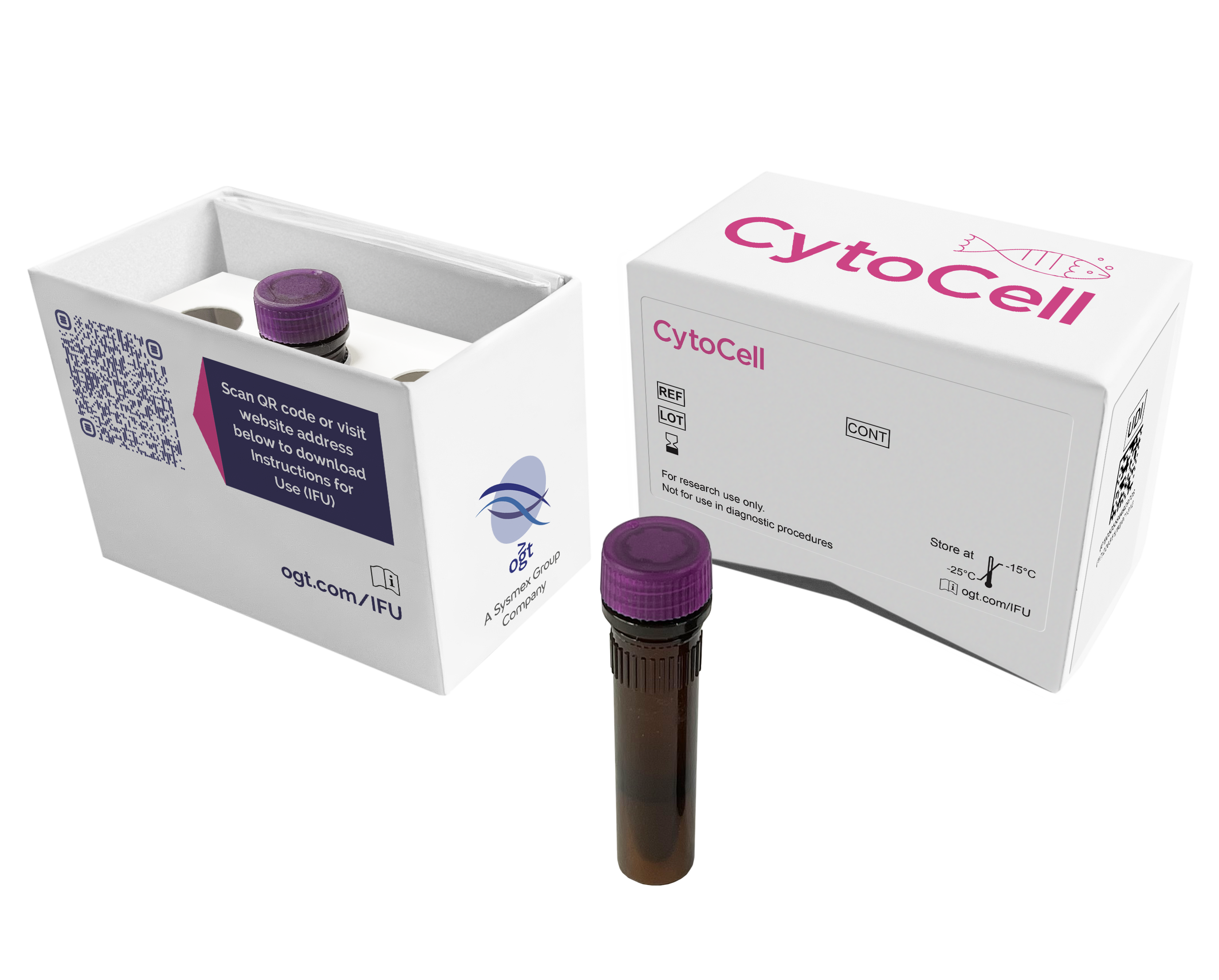
The P16 probe, labelled in red, covers a 193kb region of 9p21.3, extending from 105kb telomeric of P16 gene to 46kb centromeric of CDKN2B. The probe mix also contains a control probe for chromosome 9 (D9Z3, the heterochromatic block at 9q12) labelled in green.
The CDKN2A (cyclin-dependent kinase inhibitor 2A) gene at 9p21 is a tumour suppressor gene that has been shown to be deleted in wide range of human malignancies.
Loss of the CDKN2A gene results in cellular proliferation and dysregulation of pro-apoptotic pathways. There are two proteins produced by the CDKN2A gene: p16INK4a and p14ARF, these protein products have been linked to two tumour suppressor pathways: the RB pathway and the p53 pathway, respectively1.
Deletions of 9p that include the CDKN2A gene are frequently reported in patients with acute lymphoblastic leukaemia (ALL): in approximately 30% of adult B-cell ALLs, 30% of childhood ALLs and up to 50% of T- cell ALLs. In adult B-cell ALL, CDKN2A deletions are frequently acquired in disease progression2,3,4,5.
Deletions including the CDKN2A locus have been reported in up to a third of patients with diffuse large B-cell lymphoma (DLBCL)6 and, in glioma, CDKN2A loss has been implicated with shorter overall survival in WHO grade I-III astrocytomas7.
Losses of the CDKN2A region have also been reported in malignant mesothelioma, melanoma, and bladder cancer8,9,10.
Find certificate of analysis documentation for our CytoCell FISH probes

Our lab has been using a wide range of CytoCell FISH probes for a number of years, and have been increasing this range all the time. The probes have clear bright signals and show good reproducibility. CytoCell provides fast delivery of catalogue probes, and are very responsive when we have any queries or problems with their products.

Bridget Manasse
Addenbrookes Hospital, Cambridge University Hosiptals NHS Foundation Trust, UK
In our hands, CytoCell FISH probes have proven to be of the highest quality with bright, easy to interpret signals, thus providing confidence in our results. OGT's customer support is outstanding, as their staff are extremely knowledgeable and truly care about their customers and their customers’ needs.

Jennie Thurston
Director of Cytogenetics, Carolinas Pathology Group, USA
I first came across CytoCell FISH probes in a previous lab I worked in and I was struck by the quality of the products. Since this time, I have been recommending and introducing CytoCell probes across all application areas — now they are the primary FISH probes used in our lab. They have an excellent range of products and their ready-to-use reagent format saves considerable time.

Elizabeth Benner
Medical Technologist, University of Arizona Health Network, USA
We have been working with CytoCell fish probes for two decades because of their excellent clarity and intensity regardless of the size of the probe. It is so clear and simple to detect.
Dr. Marina Djurisic
Head of Laboratory of Medical Genetics, Mother and Child Health Care Institute of Serbia “Dr Vukan Cupic”, Serbia
The quality and consistency of CytoCell’s probes means I can trust the results, and my clients get their results in a timely manner.

Dr. Theresa C. Brown
Director, Cytogenetics Laboratory, Hayward Genetics Center, Tulane University School of Medicine, USA
It was very important for us to have more consistent results with our probes — easy-to-read bright signals and a range of vial sizes, which is much more cost-effective.

Janet Cowan, PhD
Director of the Cytogenetics Laboratory, Tufts Medical Center, USA
Not only do CytoCell offer an extensive range of high-quality FISH probes, the customer support is also excellent — providing fast access to all the probes I need. The probes are highly consistent with bright signals allowing easy scoring of results.
Dr. Eric Crawford
Senior Director, Genetics Associates Inc., USA
The quality and reproducibility of results using the CytoCell kit has been vital in accurately detecting co-deletions in our glioma investigations. We now have a cost-effective test that we can rely on that is also easy to use and interpret. We've been consistently impressed with this kit - not to mention the support offered by OGT's customer service, and have completely transitioned over to CytoCell probes.
Gavin Cuthbert, FRCPath
Head of Cancer Cytogenetics, Northern Genetics Servce, Newcastle, UK